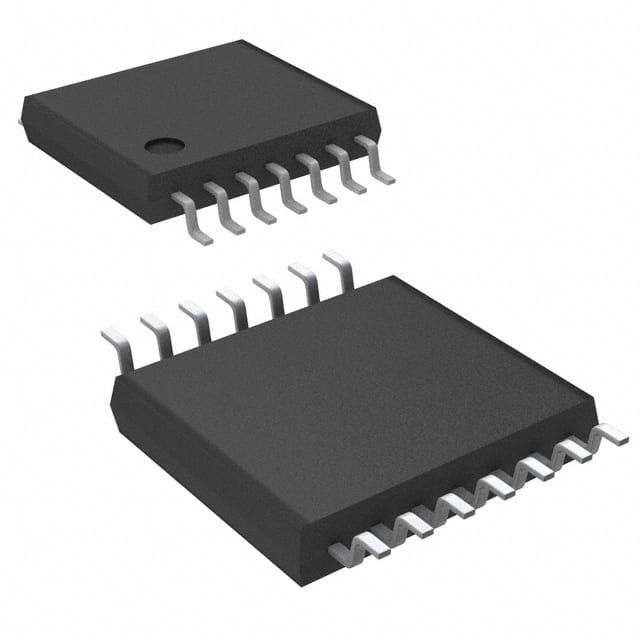Lihat spesifikasi untuk detail produk.

Encyclopedia Entry: 74AHCU04T14-13
Product Overview
Category
The 74AHCU04T14-13 belongs to the category of integrated circuits (ICs).
Use
This product is commonly used as an inverter and buffer in various electronic devices and systems.
Characteristics
- High-speed operation: The 74AHCU04T14-13 offers fast switching speeds, making it suitable for applications requiring quick signal processing.
- Low power consumption: This IC is designed to minimize power consumption, making it energy-efficient.
- Wide operating voltage range: It can operate within a wide voltage range, providing flexibility in different electronic systems.
- Small package size: The 74AHCU04T14-13 is available in a compact package, allowing for space-saving designs.
- RoHS compliant: This product meets the Restriction of Hazardous Substances directive, ensuring environmental safety.
Package and Quantity
The 74AHCU04T14-13 is typically packaged in a small outline integrated circuit (SOIC) package. It is commonly available in reels or tubes containing multiple units, with quantities varying based on manufacturer specifications.
Specifications
- Supply Voltage Range: 2V to 6V
- Input Voltage Range: 0V to VCC
- Output Voltage Range: 0V to VCC
- Operating Temperature Range: -40°C to +85°C
- Maximum Propagation Delay: 8 ns
- Maximum Quiescent Current: 4 μA
Pin Configuration
The 74AHCU04T14-13 has a total of 14 pins, each serving a specific function. The pin configuration is as follows:
Pin 1: Input A1
Pin 2: Input A2
Pin 3: Input A3
Pin 4: Input A4
Pin 5: Input A5
Pin 6: GND (Ground)
Pin 7: Output Y1
Pin 8: Output Y2
Pin 9: Output Y3
Pin 10: Output Y4
Pin 11: Output Y5
Pin 12: VCC (Supply Voltage)
Pin 13: Input A6
Pin 14: Input A7
Functional Features
- Inverting Function: The 74AHCU04T14-13 can invert the input signal, providing an inverted output.
- Buffering Function: It can also act as a buffer, amplifying and maintaining the integrity of the input signal at the output.
Advantages and Disadvantages
Advantages
- High-speed operation enables quick signal processing.
- Low power consumption contributes to energy efficiency.
- Wide operating voltage range allows for versatile applications.
- Compact package size facilitates space-saving designs.
- RoHS compliance ensures environmental safety.
Disadvantages
- Limited number of inputs and outputs may restrict certain complex applications.
- Propagation delay of 8 ns may not be suitable for ultra-high-speed applications.
Working Principles
The 74AHCU04T14-13 utilizes complementary metal-oxide-semiconductor (CMOS) technology. It consists of multiple transistors arranged in a specific configuration to achieve the desired inverting and buffering functions. When an input signal is received, the internal circuitry processes it accordingly and produces the corresponding inverted or buffered output.
Application Field Plans
The 74AHCU04T14-13 finds extensive use in various electronic systems, including: - Digital logic circuits - Microcontrollers - Data communication devices - Computer peripherals - Consumer electronics
Alternative Models
For those seeking alternative options, the following ICs provide similar functionality: - SN74LVC04A - MC74VHC1G04 - CD4049UB
These alternative models can be considered based on specific requirements and compatibility with the intended application.
In conclusion, the 74AHCU04T14-13 is a high-speed, low-power inverter and buffer IC. Its compact size, wide operating voltage range, and RoHS compliance make it suitable for various electronic applications. However, its limited number of inputs and outputs may restrict certain complex designs. Understanding its specifications, pin configuration, functional features, advantages, disadvantages, working principles, application field plans, and alternative models allows for informed decision-making when incorporating this IC into electronic systems.
Sebutkan 10 pertanyaan dan jawaban umum terkait penerapan 74AHCU04T14-13 dalam solusi teknis
Sure! Here are 10 common questions and answers related to the application of 74AHCU04T14-13 in technical solutions:
Q: What is the 74AHCU04T14-13? A: The 74AHCU04T14-13 is a hex inverter with Schmitt-trigger inputs, which means it can convert input signals from one logic level to another.
Q: What is the operating voltage range of the 74AHCU04T14-13? A: The operating voltage range is typically between 2V and 5.5V.
Q: Can the 74AHCU04T14-13 be used for level shifting? A: Yes, the 74AHCU04T14-13 can be used for level shifting as it can convert signals from one logic level to another.
Q: What is the maximum output current of the 74AHCU04T14-13? A: The maximum output current is typically around 8mA.
Q: Can the 74AHCU04T14-13 be used in high-speed applications? A: Yes, the 74AHCU04T14-13 is designed for high-speed operation and can be used in applications that require fast signal processing.
Q: Does the 74AHCU04T14-13 have built-in protection against overvoltage or ESD? A: No, the 74AHCU04T14-13 does not have built-in protection against overvoltage or electrostatic discharge (ESD). External protection measures may be required.
Q: How many inverters are there in the 74AHCU04T14-13 package? A: The 74AHCU04T14-13 package contains six inverters.
Q: What is the typical propagation delay of the 74AHCU04T14-13? A: The typical propagation delay is around 4.5ns.
Q: Can the 74AHCU04T14-13 be used in both CMOS and TTL logic systems? A: Yes, the 74AHCU04T14-13 is compatible with both CMOS and TTL logic systems.
Q: Are there any specific temperature requirements for the 74AHCU04T14-13? A: The 74AHCU04T14-13 has a recommended operating temperature range of -40°C to +85°C.
Please note that these answers are general and may vary depending on the specific datasheet and manufacturer's specifications for the 74AHCU04T14-13.

